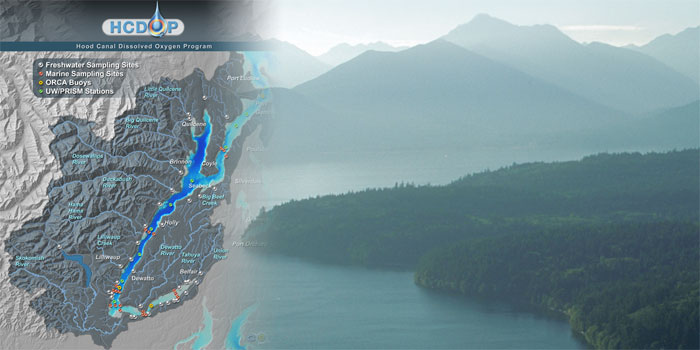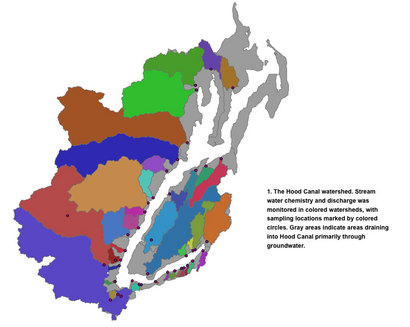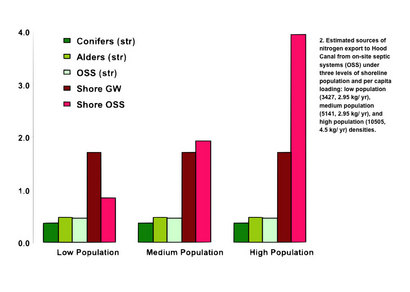Hood Canal

Solving the dissolved oxygen puzzle in Hood Canal
While partly a natural phenomenon, low dissolved oxygen concentrations in southern Hood Canal have grown more frequent and intense in recent years, resulting in several major fish kills. With the twin goals of determining the primary causes of the problem and recommending corrective actions, federal, state, regional, and local agencies partnered with the University of Washington to initiate the Hood Canal Dissolved Oxygen Program in 2005.
PRISM's primary role in HCDOP has been to establish the source, quantity, and timing of nitrogen inputs and freshwater flow into Hood Canal. Nitrogen fertilization of phytoplankton is frequently the cause of low dissolved oxygen (hypoxia) in marine waters. A combined analytical and modeling approach was adopted to estimate nitrogen loading to Hood Canal, and in particular the Lynch Cove area where hypoxia is most severe.
Three main sources of human-caused nitrogen inputs were identified:
- Population density - Hood Canal has experienced substantial population growth, especially along the shoreline, over the past several decades. Nitrogen loading from septic tanks and other domestic sources can be a major influence on nitrogen loading.
- Red alder - A vigorous nitrogen-fixing species that is native to the Hood Canal area, red alder's distribution has expanded greatly in response to timber cutting, road construction, and other activities that disturb the natural conifer-dominated forest.
- Atmospheric deposition - Although Hood Canal is upwind of major North American population and industrial centers, even small increases in atmospheric nitrogen may be ecologically significant when concentrated in the hydrologic network.
Other sources, such as forest fertilization and agriculture, were considered but judged to be of minor importance.
Delivery of nitrogen to marine waters is also influenced by processes that remove nitrogen from water sources, including uptake by biota, microbially-mediated transformation to nitrogen gas (denitrification), and adsorption to soils and sediments. The effectiveness of these processes differs in soil, stream and groundwater environments, and with the length of time solutes are exposed to each. Hence, the path that nitrogen follows to reach marine waters can make a large difference in the amount exported. Three pathways of nitrogen delivery to Hood Canal were addressed:
- Stream export - For medium and large-sized watersheds, most rain water is eventually intercepted by stream channels, where microbial uptake and denitrification removes a significant proportion of nitrogen.
- Groundwater export - As shown in gray on Figure 1, much of the Hood Canal watershed drains into marine waters through groundwater (with some surface runoff during storms), rather than through stream channels. Nitrogen export from these areas is not subject to stream removal and often has higher nitrogen concentrations than stream water.
- Shoreline groundwater export - Groundwater movement in areas near the shore is influenced by tidal flows and has a shorter path to marine waters than groundwater from upslope areas. Septic systems in these areas are expected to have the highest nitrogen loading rates.
Methods
Complementing analytical and modeling approaches were used to estimate stream nitrogen export and other factors contributing to nitrogen loading. Water samples and stream discharge measurements, collected from the 43 largest streams every month from 2005 through the end of 2007, were used to estimate stream nitrogen export. Regression analysis was used to relate observed nitrogen export in each stream to potential sources: population density was derived from 2000 US Census tract data; red alder distribution was derived from a landcover classification based on LANDSAT multispectral images; and atmospheric deposition was derived from a National Atmospheric Deposition Program sampling station located on the Hoh River. These data were also used as inputs to D-SEM (D-Solute Export Model), a simulation model that couples a watershed hydrological model (Distributed Hydrology Soil Vegetation Model -DHSVM) with a chemistry model to simulate the movement of water and nutrients as they move through soil, groundwater and stream environments. Simulating different levels of simulated population, red alder cover, and atmospheric deposition provided a basis for estimating the influence of each.
Compared to stream export, groundwater nitrogen flux is difficult to measure. Several methods were used to estimate groundwater nitrogen export: extrapolation of areal nitrogen yield from sampled watersheds to unsampled watershed areas; United States Geological Survey measurements of groundwater discharge and nitrogen using seepage meters, piezometers and geochemical tracers; and mass balance calculations. Estimated ranges of tidal groundwater nitrogen loading were based on population within 500 m of the shoreline.
Results
Total nitrogen export to Hood Canal from the surrounding watershed is estimated at 700 metric tons/year, with most nitrogen loading occurring in the winter when it is of little consequence to phytoplankton production and hypoxia in Hood Canal. However, there was substantial uncertainty in estimates of groundwater nitrogen loading, which plays a particularly important role in the summer, when stream export is low.
Stream Export
Based on monthly measurements, average annual stream N export was estimated at 400 metric tons for all of Hood Canal and 60 metric tons for Lynch Cove. Simulation results yielded somewhat lower estimates of Lynch Cove stream nitrogen export (52 metric tons/year). Regression of measured stream nitrogen and model results both identified population and red alder as important nitrogen sources. Regression analysis suggested that 52% of nitrogen export was due to red alder and 31% was due to population density. Simulation results indicated that 35% of nitrogen export was due to red alder and 16 % was due to population density. However, most stream export occurred during the fall and winter, with only about 15% occurring during the summer months of June through October, when phytoplankton production and hypoxia are key issues.
Groundwater Export
Measured nitrogen concentrations in groundwater were spatially highly variable, ranging from 0 to about an order of magnitude higher than concentrations measured in summer stream samples. When combined with various estimates of shoreline groundwater discharge (which were all much higher than summer stream discharge), this yielded estimates of summer groundwater nitrogen export that were up to 10 times higher than summer export from streams. Nitrogen loading from septic systems in the immediate shoreline area, in particular, suggests a particularly high potential for nitrogen loading from septic systems (Figure 2).
Conclusions
Whereas most stream export occurs in the fall and winter, groundwater continues to export substantial amounts of nitrogen during the summer, when it can stimulate phytoplankton production. Groundwater is therefore the largest source of nitrogen potentially contributing to hypoxic conditions in Hood Canal. However, there remains considerable uncertainty in the magnitude of groundwater inputs - particularly from shoreline areas. Hood Canal appears to have a high natural susceptibility to groundwater contamination of marine areas due to a porous aquifer and predominance of small basins that maximizes the amount of marine boundary relative to watershed size. High population density along the shoreline appears to be the single greatest source of marine contamination. Refining the magnitude and source of groundwater nitrogen export is the focus of continuing investigation.


